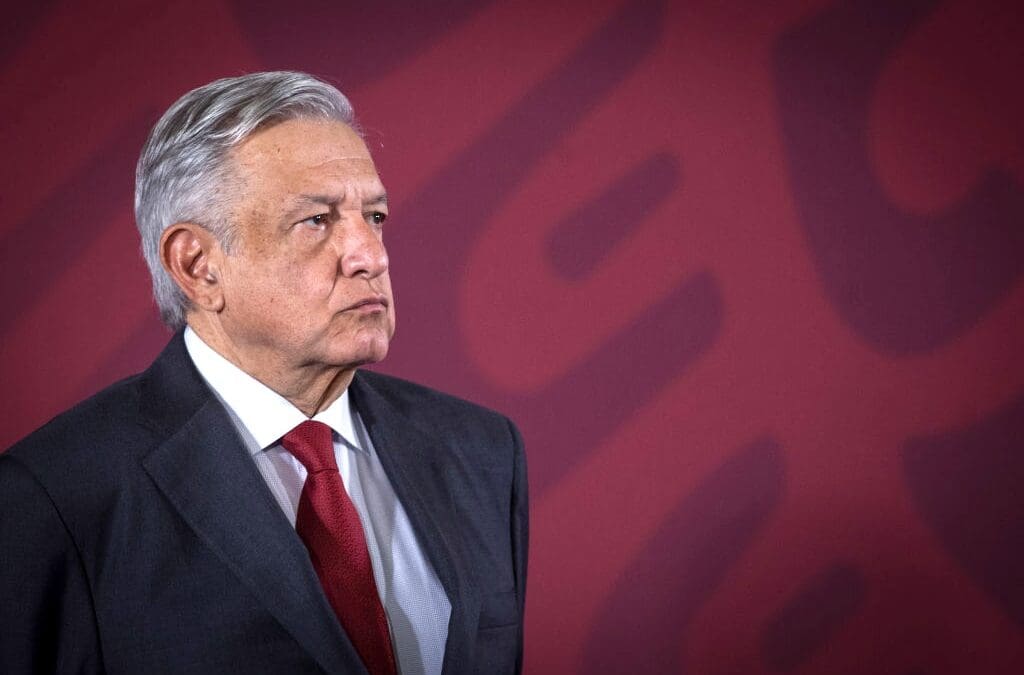
‘As Journalists, It’s All About Us Being Authentic and Telling the Truth’: Darlene Rodriguez on 25 Years at NBC New York
April 5, 2025
Senate GOP passes budget plan, setting up a critical next phase for Trump agenda
April 5, 2025
On the night of July 1, 2018, Mexico City’s main square, Zócalo, filled with people ready to celebrate the results of the presidential election. Among the ebullient throng — and despite the fact that AMLO’s challengers had already conceded following a preliminary announcement by the National Electoral Institute at 8 p.m. — were a number of signs decrying the foul play many were sure was still afoot.
After so many years of repression, violence, media kneecapping, and electoral swindles, many among Mexico’s long-suffering left simply could not believe they would be allowed to win. But win they had: on his third and self-proclaimed final try, Andrés Manuel López Obrador (AMLO) had defeated his closest rival by a fraud-proof margin of some thirty points. Riding his coattails, the young MORENA party — formally registered barely four years earlier — captured commanding majorities in both houses of Congress and dominated down-ballot races. The daunting task of governing a country torn by a combination of scorched-earth neoliberalism and a fratricidal drug war was now set to begin.
Five months to the day later, AMLO was en route to Congress to take his oath of office when a cyclist caught up to the motorcade. “En ti confiamos,” he said to the president-elect through the window of his modest Volkswagen Jetta. We trust you. Once the ceremonies were complete, AMLO was to waste little time in beginning to dismantle the trappings of the imperial Mexican presidency: turning the lavish presidential residence Los Pinos into a cultural center; converting the once-feared Islas Marías penitentiary into a nature reserve; and putting the presidential plane up for sale, together with fleets of superfluous federal planes and cars.
And where presidents had once been remote and aloof, AMLO launched, his first mañanera: a daily, freewheeling morning press conference sometimes running up to three hours in length. Despite boilerplate warnings that such conferences would reduce the presidential image to that of an everyday press secretary, the combined information session, debate club, history lesson, and stand-up routine had precisely the opposite effect, allowing AMLO to go over the heads of a hostile media and set the agenda while, over time, vaulting into the top ten Spanish-language streamers worldwide. Some 1,437 more mañaneras were to follow this first one, becoming a national institution that current president Claudia Sheinbaum has wisely decided to continue.
Three of AMLO’s other early battles were to prove equally symbolic. The first was the fight against the organized theft of gasoline (known as huachicol) from the ducts of the state oil company PEMEX, a practice that was bleeding the state dry.
The second was the cancellation of the Mexico City airport boondoggle he inherited from his predecessor, Enrique Peña Nieto; in addition to its lavish construction costs, the project would require a never-ending stream of lucrative contracts to keep it from sinking into the Texcoco lakebed it was to be built upon. Instead, the decision was made to refurbish and expand an existing military airport in Santa Lucia, in the north of the city: a wise decision in terms of cost savings but one that also foreshadowed a reliance on the armed forces for policing and public-works projects, something that would prove to be one of the most controversial aspects of his administration. By March 2019, the newly minted militarized police, the National Guard, had been legally constituted.
And the third was the Maximum Salaries Law for the top federal bureaucracy, one of the first to be passed by the MORENA congressional majority. Both AMLO’s railing against the “phaoronic” state of gilded excess, and the opposition’s falling into the trap of not only opposing the law but suing to block it, was to mark much of the political dynamic that was to play out in subsequent years.
As AMLO’s first full year in power dawned, Time magazine included Mexico on its list of Biggest Geopolitical Risks for 2019. “[AMLO’s] bid to roll back the opening of Mexico’s economy, orthodox macroeconomic policies, privatizations, and deregulation threaten a return to the 1960s,” Ian Bremmer warned gravely. “In 2019, he’ll spend money Mexico doesn’t have on problems like poverty and security that resist straightforward solutions.”
Bremmer, not surprisingly, was completely wrong: indeed, one of the president’s most successful balancing acts was to enact a wide range of social programs and public-works projects while maintaining macroeconomic stability. As for “resisting straightforward solutions,” even the World Bank was forced to admit that the programs, combined with annual minimum-wage increases and other measures designed to boost earnings, lifted some 9.5 million Mexicans out of poverty over the course of his term.
Building on his experience as mayor of Mexico City, AMLO expedited the rollout of the programs by making them universal and cash transfer–based; notable exceptions were Jóvenes Construyendo el Futuro (Youth Building the Future), in which young people who were neither working nor studying could apply for one-year apprenticeships paid by the federal government, and Sembrando Vida (Planting Life), a community-based tree planting and plant-husbandry initiative. Notably, these were the two programs that AMLO repeatedly requested that the United States help him extend to Central America in a bid to attack the root causes of migration.
The social programs came just in time: in March of 2020, the COVID-19 pandemic hit with all of its deadly force. Mexico, slower to feel the brunt than the United States, soon started racking up its share of contagions and deaths. Instead of pivoting to his national infrastructure plan, the AMLO administration was forced to confront the crisis with the nation’s dilapidated public health care system, debilitated by a post-NAFTA obesity epidemic, a mafia of pharmaceutical distributors in which ten companies controlled 80 percent of the market, and the federal government’s neoliberal abandonment of health under the guise of “handing it back to the states.”
While engaging in this crash program of building out bed capacity and procuring vaccines, and with annual GDP in the process of tumbling some 8.6 percent, the administration made a trio of crucial decisions that were to set off the moralizing opprobrium of first-world finger-waggers: refusing both mandatory lockdowns and border closures as well as subsidies for business payrolls. With half of the country working in the informal economy, the president wagered, requiring people to stay home would be a suicide pact. By the same token, subsidizing formal-sector payrolls would essentially be a giveaway to those more well-off at the expense of everyone else, and with the possibility of dangerous indebtedness to international institutions.
Instead, families pooled their social-program funds: students their stay-in-school scholarship money, grandparents their universal senior pension, single mothers and those on disability benefits, and so on. As it all shook out — allowing for potential variances due to undercounting — Mexico came in at around 2,500 deaths per million, better than the United States and a number of other countries with more developed health systems, but scant comfort to those who spent day after day begging for unavailable oxygen tanks on social media while a family member slowly suffocated to death.
The year 2020 closed out with the Cienfuegos affair, in which retired general and former secretary of defense Salvador Cienfuegos Zepeda was arrested in Los Angeles on charges of drug trafficking, only to be released and returned to Mexico a month later. To blunt criticism that he was bending over backward to appease the military, AMLO made public the full file of evidence provided by the United States against the general: 751 pages of BlackBerry messages and message transcripts that was, indeed, remarkably thin.
Anger over the affair and years of US intelligence-agency meddling culminated in the National Security Act, which reined in the activities of these agencies on Mexican soil. The Drug Enforcement Administration’s (DEA) anger over this legislation, in turn, would spur a series of leaks to willing stenographers in US corporate media in a sleazy attempt to tie AMLO’s three presidential campaigns with drug traffickers — just in time for the 2024 presidential election.
An even larger fight, also involving the United States, was brewing for 2021: energy reform. In March, AMLO signed into law the Electric Industry Act which, among other measures, required that the nation’s electrical grid acquire its energy first from public sources and then, as necessary, from private ones. The ink was barely dry when it was hit by a battery of injunctions and lawfare at the behest of jilted energy multinationals. US ambassador Ken Salazar — a fossil fuel lobbyist cosplaying as a clean-energy advocate — jumped onto the pile-on to express his “concerns” about the law. When the conservative-majority Supreme Court eventually struck down the law several years later, AMLO was to up the ante: give me a supermajority in Congress so that we can pass, as constitutional amendments, not only the energy reform but an overhaul of the nation’s supremely corrupt judicial system to provide for the direct election of justices. Voters would oblige.
But first MORENA had to get through the midterm elections. Despite desperate last-minute screeds from outlets ranging from the Economist to the Nation, the president’s coalition held Congress, albeit with a number of embarrassing losses in Mexico City due to a combination of poor candidates, internal machinations, and the lingering effects of the collapse of an elevated section of the Línea 12 subway line.
AMLO proclaimed himself to be feliz, feliz, feliz (happy, happy, happy) with the results. In July, the president gave the most important foreign policy speech of his administration at a ceremony commemorating the birthday of revolutionary leader Simón Bolivar. Noting that the since the 1898 sinking of the battleship USS Maine, “Washington has never ceased carrying out overt or covert operations against the independent countries south of the Rio Grande,” AMLO called for a united Latin America and the replacement of the Washington-dominated Organization of American States (OAS) with a truly autonomous organization that is “not a lackey of anyone.”
However haltingly, Mexico under AMLO was beginning to rediscover its footing as a regional leader capable of tracing an independent line in foreign policy. When Bolivian president Evo Morales was toppled in 2019 with the backing of both the Trump administration and the OAS, the Mexican president sent a plane to rescue him. When President Pedro Castillo of Peru was ousted and jailed, AMLO had no qualms about calling it what it was: a coup.
AMLO openly supported Cuba, refused to toe the US line on Ukraine (going so far as to insist that the war was being “stoked by the interests of the arms industry”), and on the occasion of the Summit of the Americas, held in Los Angeles in 2022, declined to attend unless all of the nations of Latin America without exception were invited. But under clear pressure from the north, he soon modified his “united Latin America” proposal to a “united Americas” one that would include the United States, a line which President Sheinbaum maintains to this day.
AMLO began 2022 with a buoyant approval rating of 67 percent, which he would put to the test in April by handily winning Mexico’s first-ever recall election, fulfilling a campaign promise to call one halfway through his term. That same month, Congress passed another highly symbolic law nationalizing the nation’s lithium stores, ranked as the tenth-largest in the world. The administration took further steps toward bolstering the nation’s energy sovereignty by purchasing the Deer Park refinery in Texas and inaugurating a self-built refinery at Dos Bocas, Tabasco, in July. These steps culminated in a massive November rally in Mexico City in which an estimated 1.2 million inundated the capital to celebrate the four-year anniversary of the “fourth transformation,” or 4T, as the movement is known. Toward the front, the president marched without security, jostled among the push-and-pull of the crowd, leading to what was to become the most iconic picture of his years in power.
Not everyone was so excited, however: in January of the following year, the London-based, National Endowment for Democracy-funded Index on Censorship named AMLO its “Tyrant of the Year” for 2022 based on an online voting process in which anyone could go in and vote the number of times they wanted. This was only a more grotesque example of an international full-court press melding corporate media, the NGO-sphere, and slavish national elites in a fevered attempt to portray AMLO as a rabid authoritarian out to torch the bases of Mexico’s managed democracy and the toxic stew of violence, privatizations, and inequality it had produced.
The campaign hit a fever pitch when, in February 2023, Congress passed a law reforming the National Electoral Institute in order to rein in excesses and make it easier for migrants living abroad to vote. When the Supreme Court duly struck it down, it was then that the “Plan C,” or push to win a congressional supermajority, was officially born.
Some three months later, at the beginning of June, the Palestinian Ministry of Foreign Affairs and Expatriates announced that its diplomatic mission in Mexico had been reclassified as an embassy. So quietly did this recognition of the state of Palestine happen that many people failed to notice. But not only did the move bring Mexico into line with the settled consensus in Latin America, it also placed the nation ahead of the curve of the recognitions that were to come following October 7 and the brutal destruction of Gaza.
As AMLO’s government rolled into the homestretch, it was making clear advances on the hundred pledges it had made on Inauguration Day. But one that, by the president’s own admission, he failed to deliver on was #89, the promise to get to the truth of what had happened with the forty-three teaching students of the Ayotzinapa Normal School disappeared in 2014.
While advances were made in the first half of his administration — further discrediting the “historic truth” peddled by his predecessor, Enrique Peña Nieto — the door began to close in the second half following the resignation of special prosecutor Omar Gómez Trejo in September 2022. It was distressing to watch López Obrador, who had been so eloquent on the case from the opposition, begin to echo the same language being used by the armed forces in a clear attempt to stonewall the investigation. Worse still, it turned out that the army, using the Israeli spy software Pegasus, was snooping on journalists, activists, and the head of the Ayotzinapa Truth Commission, Alejandro Encinas.
AMLO’s reliance on the military can be understood from a number of different angles. First, the utter corruption and infiltration of the police forces he inherited, as exemplified by the thirty-eight-year prison sentence given to former “top cop” Genaro García Luna, the security minister in the conservative government of Felipe Calderón, for collusion with the Sinaloa Cartel. Second, the hollowing-out of the state during the neoliberal era, leaving the armed forces as practically the only branch of government with the organizational and engineering wherewithal to take on and manage large projects.
Third, and most pragmatically, the need for any left-leaning government in Latin America to grapple with — and neutralize — the devastating history of military coups throughout the region. But it was in the case of the 2014 Ayotzinapa mass kidnapping of students, and the military’s stubborn cover-up of its participation in it, where the pound of flesh it demanded of López Obrador in exchange for its support became most glaringly evident.
There were other things. Crooked employees embezzled some 2.7 billion pesos (US $135 million) from the Mexican Food Security Agency (SEGALMEX), established in the first years of the government to stimulate domestic food production and distribution. In March of 2023, a fire at a migrant detention center operated by the National Institute of Migration (INM) killed forty, the culmination of years of shabby treatment of migrants heightened by an unsatisfactory deal made with the Trump administration in 2019. In both cases, AMLO — loyal to a fault — defended the agencies’ directors. But none of this was enough to shake the fundamental conviction of the Mexican public that the country was in a much better place. As the 2024 presidential elections neared, and as Sheinbaum, then mayor of Mexico City, sewed up the presidential nomination, the MORENA coalition looked poised to roll to a second-straight electoral victory.
For a cross-border elite linked by a dense web of think tanks and ostensibly nonpartisan academic institutes, this could not stand. In late January, just as campaigns were heating up, ProPublica, InSight Crime, and Deutsche Welle came out on the same exact day with pieces on the same exact topic: the supposed relationship between organized crime and AMLO’s first presidential campaign in 2006.
The pieces, clearly based on the same batch of leaks from the DEA, consisted of little more than cobbled-together bits of hearsay. Even more substance-free was a New York Times piece in February making the same insinuations about López Obrador’s 2018 campaign. But that did not stop a well-financed deployment of bots and international troll farms from flooding social media and turning #NarcoAMLO and #NarcoPresidente into multiday trending topics.
What might have been devastating in other contexts here utterly backfired: AMLO’s popularity rose by eleven points and the polling gap between Sheinbaum and her right-wing opponent, Xóchitl Gálvez, widened by ten. From there, Sheinbaum’s disciplined, rack-up-the-miles campaign was more than enough to cross the finish line: not only did she defeat Gálvez by some thirty-two points, but the MORENA coalition had won its supermajority in Congress. AMLO’s “Plan C” gamble had paid off spectacularly.
On Monday, September 30, 2024, AMLO held his final mañanera; an animated montage at the beginning reviewed the highlights of his career and bade him farewell. The following day, again in his Volkswagen Jetta, he attended President Sheinbaum’s inauguration ceremony in Congress for the formal handing-off of the presidential sash. And then the man who had bestrode the Mexican political scene for a generation was gone.
Andrés Manuel López Obrador had had the last laugh: despite years of right-wing fearmongering that he was going to change the constitution to reelect himself indefinitely, he was off to his ranch in Chiapas to retire and write. His greatest legacy, however, was what he left behind: a strengthened movement, a more politically engaged population, and a heightened sense of national pride. “AMLO taught us to respect ourselves again,” said a street bookseller on inauguration day. “And to hell what they think of us abroad!”
Great Job Kurt Hackbarth & the Team @ Jacobin Source link for sharing this story.








